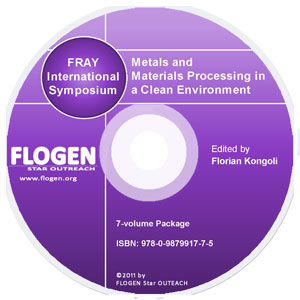
CD shopping page |
2011-Sustainable Industrial Processing Summit
|
| Editors: | Florian K |
| Publisher: | Flogen Star OUTREACH |
| Publication date: | 9 January 2012 |
| Pages: | 630 pages |
| ISBN: | 978-0-9879917-2-0 |
| ISSN: | 2291-1227 (Metals and Materials Processing in a Clean Environment Series) |
Galvanostatic Studies On The Electro-deoxidation Of Solid Titanium Dioxide In Molten Calcium Chloride
Mohandas K.S.1; Shakila L. 2; Sanil N.2; Sri Maha Vishnu D. 2; Nagarajan K. 2;1INDIRA GANDHI CENTRE FOR ATOMIC RESEARCH, Chennai, India; 2INDIRA GANDHI CENTRE FOR ATOMIC RESEARCH, Kalpakkam, India;
Type of Paper: Regular
Id Paper: 63
Topic: 6
Abstract:
Electro-deoxidation of metal oxides in molten chloride medium to produce metals and alloys is an area of great interest in pyroelectrometallurgy today. Several metal oxides have been reduced by the process and efforts are now underway to develop the process for commercial exploitation.In the FFC Cambridge process, the solid oxide is electro-deoxidised in molten calcium chloride medium at 850-950 oC with graphite as the counter electrode. Generally the process is carried out under a constant applied voltage in the range of 2.8-3.1V between the solid oxide cathode and graphite anode. Several metal oxides have been reduced by this process and TiO2 assumes a special place in these investigations owing to the commercial interests of titanium metal in the modern world. We have been studying the electro-deoxidation process with different metal oxides like UO2, Nb2O5, CeO2, ZrO2 in both constant current (CC) and constant voltage (CV) modes. We report in this paper the results of the investigations carried out on the electro-deoxidation of powder compacted and sintered TiO2 pellets by galvanostatic electrolysis, for the first time. These investigations are also unique because we have measured the half-cell potentials of the electro-deoxidation cell during the entire course of electro-deoxidation of the metal oxide to metal using an in-house developed graphite psuedo-reference electrode. The results of the investigations are very encouraging and they could provide the answers to some of the very fundamental questions on the FFC Cambridge process, which cannot be otherwise sorted out by the conventional method of CV electrolysis. Some of these questions are :(i) Is FFC Cambridge process a calciothermic reduction process or an oxygen ionization process? (ii) What are the cathodic and anodic potentials of the process? (iii) What is the magnitude of polarization possible for an electrode under a given electrolysis condition? (iv) How does the electrical resistance of the cathode and the cell change during electro-deoxidation and what are its implications? .